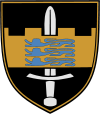Estonian Army
| Estonian Land Forces | |
|---|---|
| Maavägi | |

Estonian Land Forces emblem
|
|
| Active | 1918–present |
| Country |
|
| Type | Army |
| Role | Land warfare |
| Size | 6,425 personnel, 35,350 personnel mobilized |
| Equipment | Equipment of the Estonian Land Forces |
| Engagements |
War of Independence (1918-1920) Afghanistan War (2001) Iraqi war (2003) |
| Commanders | |
| Notable commanders |
Johan Laidoner |
| Insignia | |
| War flag |  |
The Estonian Land Forces (Estonian: Maavägi), unofficially referred to as the Estonian Army, is the name of the unified ground forces among the Estonian Defence Forces where it has an offensive military formation role. It is currently also the largest military branch with the average size during the peacetime with around 6,000 soldiers, conscripts and officers.
The Maavägi development priorities are the capability to participate in missions outside the national territory and the capability to perform operations to protect the territory of Estonia, also in co-operation with the Allies. The Maavägi component of the operational structure consists of an infantry brigade and a homeland security structure. Deployable infantry battalion tactical group and some deployable CS, CSS units will developed in the Army structure in accordance with NATO Force Proposals requirements. Infantry brigade will act as a training and support frame for deployable units. Homeland security structure units will have the capability to carry out territorial military tasks and support civil structures.
The Land Forces are structured according to the principle of a reserve force which means that the main part of the defence forces of the state are units in a trained reserve. For a state with few human and economic resources, a reserve force based on the will of defence of the citizens is the only viable form of national defence.
In peacetime the reservists conduct normal lives and the state takes care of their training and the procurement of equipment and weapons. In wartime the reservists are mobilized into military units. The reserve units are formed on the territorial principle, i.e. conscripts from one area are called up at one time to one unit and after service they are sent to the reserve as one unit. The Estonian Army is always in constant defence readiness in co-operation with the other services.
The 1st and 2nd Divisions were created during the Estonian War of Independence, the 2nd Division in December 1918-January 1919. The Scouts Single Infantry Battalion was formed on 21 December 1918.
On 21 November 1928 eight 'Single Infantry Battalions' were created. The peacetime purpose of these battalions was to train conscripts. In wartime the battalion would reorganize itself into a regiment with a similar order of battle as the two initial reaction force regiments covering the eastern and southern borders. Each battalion's peacetime strength was a total 237 soldiers, in a regimental staff, a Signal Platoon, an Engineering Platoon, a Ski-Bicycle Platoon, a Building Platoon, and three infantry companies.
...
Wikipedia
